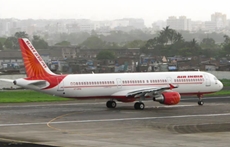Air India ceding market, trimming fleet amidst revival talks!
06 Jun 2015
The government is talking of reviving the beaten down national flag carrier Air India even as the domestic carrier continues to lose market share to foreign carriers and new Indian carriers.
 The original government-funded revival plan of Air India had not envisaged the Jet-Etihad deal as well the entry of new operators like AirAsia India and Vistara on the horizon as well as the oil prices, which declined by 39 per cent last fiscal.
The original government-funded revival plan of Air India had not envisaged the Jet-Etihad deal as well the entry of new operators like AirAsia India and Vistara on the horizon as well as the oil prices, which declined by 39 per cent last fiscal.
The Rs30,000 crore rescue plan was on the conditions that the airline would achieve certain targets in absolute numbers like seat factor, number of aircraft in the fleet, on-time performance and revenue among others in each year. The carrier has not yet achieved any of these "milestones."
The government has now asked SBI Capital Markets to review Air India's turnaround plan in the backdrop of the "drastic changes" in the ground situation over the last three years and submit a report to it within three months.
Air India has reported losses to the tune of Rs5,389 crore and Rs5,490 crore, respectively, in the fiscals 2013-14 and 2012-13, respectively.
The airline is saddled with a debt of about Rs40,000 crore that includes long-term loan taken for aircraft purchase and working capital loan. It has accumulated a loss of close to Rs30,000 crore.
Meanwhile, Air India has shelved its plan to acquire five Boeing 787-9, the higher range variant of Boeing Dreamliner (787-800) aircraft, after failing to secure the nod of its board and would stick to the original model.
Of the 68 planes that Air India agreed to buy from American aircraft maker Boeing Co in 2005, 27 are the Boeing 787-800s. The rest 41 are Boeing 777s (23) and 737-800 (18). It has currently 20 Dreamliners in its fleet.
Of the remaining seven planes, which are to be delivered to the Air India by mid-2016, the carrier had late last year proposed to replace five of them with Boeing 787-9.
Airlines around the world are now in talks with Air India for a share of the lucrative Indian market even as the Indian flag carrier continues to lose market share and revenues.
After major Gulf carriers Etihad and Emirates increased their slots in India, smaller rival Flydubai is reported to be seeking to expand its Indian operations.
The Dubai-based low-cost airline wants to expand its coverage in India with more slots, especially in the lucrative routes that cater to Gulf Indians.
At least 14 foreign airlines, including Star Alliance partners, are also in advanced talks with Air India for stitching code-share agreements that would help them grab a pie of the lucrative Indian aviation market.
Air India is in advanced talks for a code-share with 10 Star Alliance member airlines, including Air China, Air New Zealand, Shenzhen Airlines, United Airlines, Croatia Airlines, Eva Air, Avianca, Thai Airways, Copa and Aegean Airlines.
VietJet, S7 Airlines, Air Austral and Flybe are the non-Star Alliance members that AI is in talks for a code-share.
Negotiations with two others - TAP Portugal and LOT Polish - was complete and code-shares could be signed anytime soon, sources said.
Code-share is a ticket-selling agreement between two airlines, whereby one carrier can market and sell the flights of another airline, and provide seamless travel to multiple destinations where it doesn't fly, of course at a cost.
All the available slots for flights between Dubai and India have been filled with Emirates taking the lion's share followed by others, including Air India and Flydubai.
Air India's wounds are self-inflicted by a lax bureaucracy and corruption that is rampant in state-run undertakings.
The Modi government's decision to transfer out aviation secretary V Somasundaran could be a clear sign to the aviation ministry to shun its inertia and start performing.
The civil aviation ministry has been talking of a number of issues, none of which have been decided for months on end. The aviation policy has been pending for several months and the new rule for Indian carriers to fly abroad is also yet to be cleared.
The ministry's proposed replacement for existing the 5/20 rule - that an Indian carrier be five year old and have 20 planes in its fleet to go overseas - has disabled both new and old airlines.
Amidst all these, the US restoring the top safety ranking of DGCA was mainly because of improved relations between the two countries under PM Modi, while the other 'achievement' of AI getting into Star Alliance was also out of compulsion as the alliance needed a full service partner from India to meet the onslaught of Gulf carriers.
With Ethihad swallowing Jet and Kingfisher shutting down, AI was the only option for Star.
The aviation ministry has been unable to find a solution to the Air India conundrum, so much so that it has not even found a person to head the airline. AI is like a critical patient and needs a special care and professional management.





















